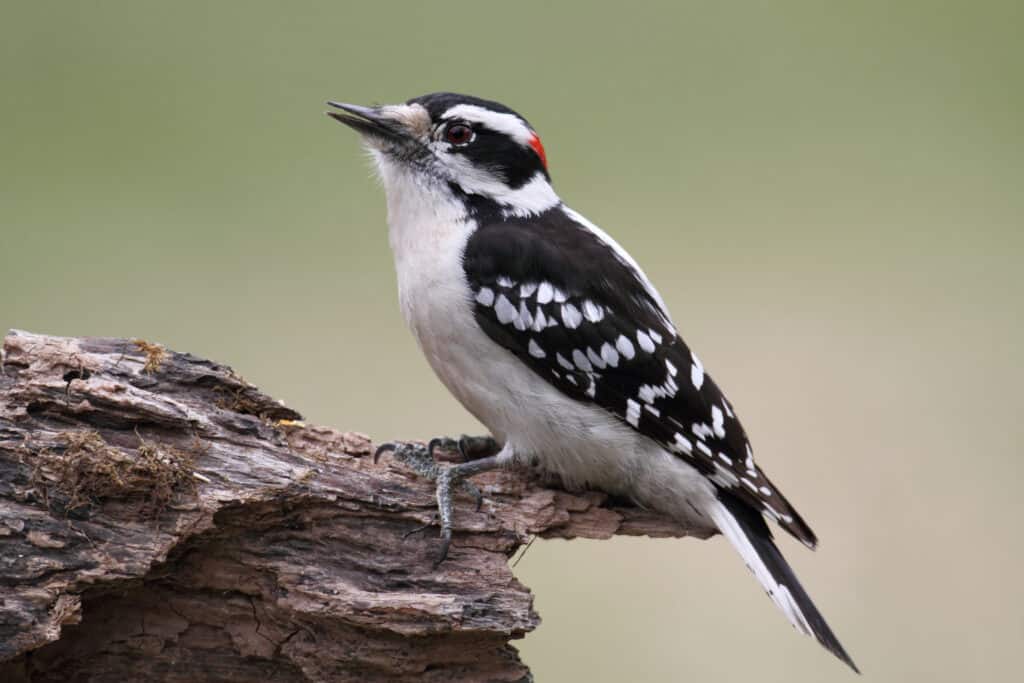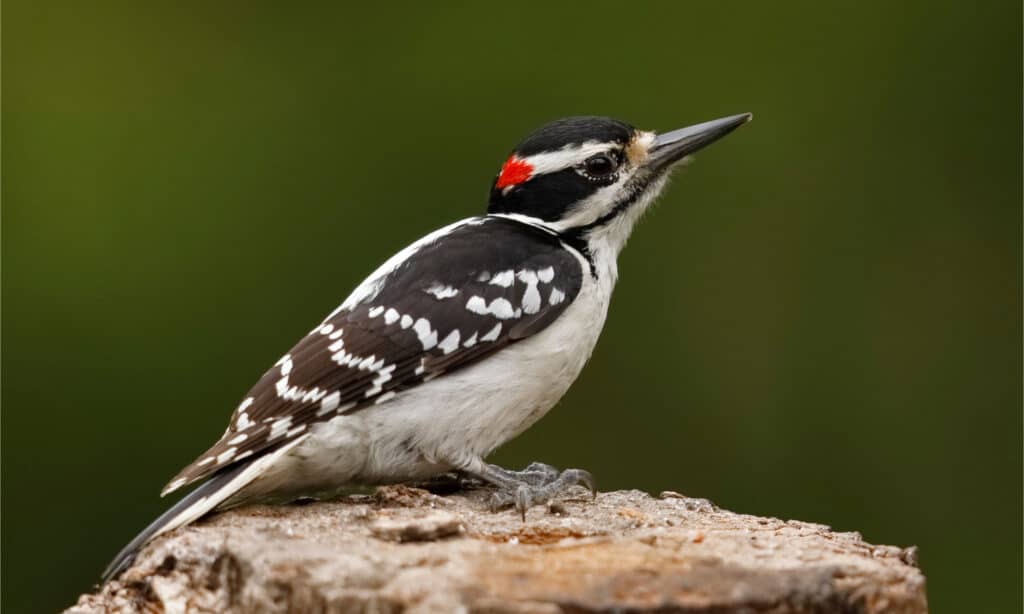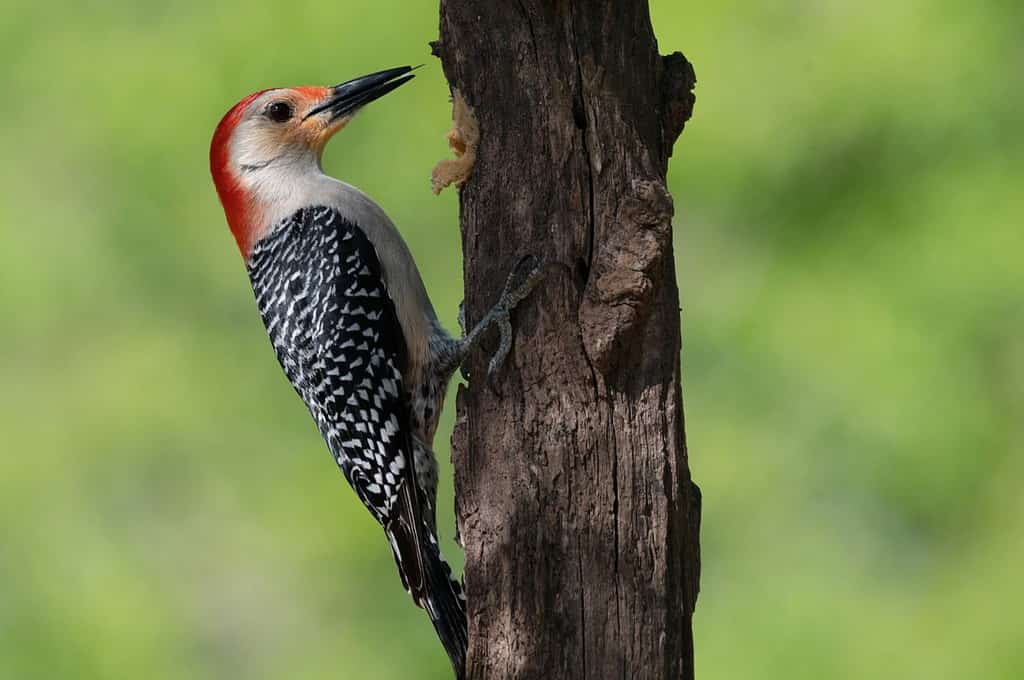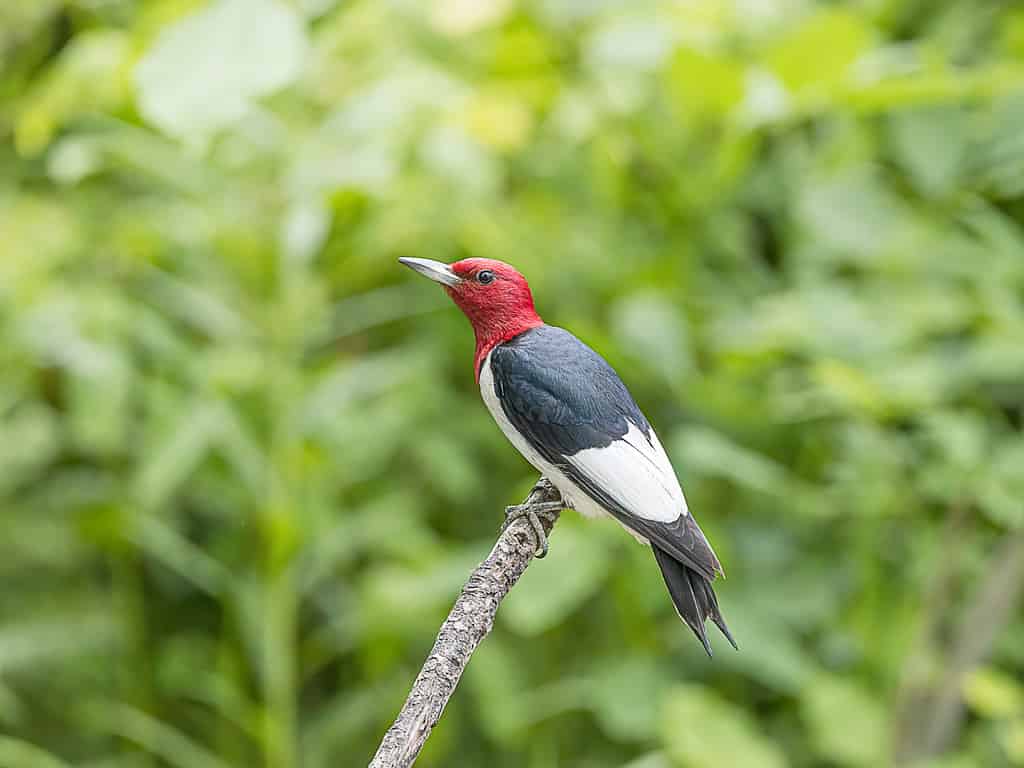Seven different species of woodpeckers can be found in Tennessee. These include the Downy Woodpecker, the Hairy Woodpecker, the Northern Flicker, the Pileated Woodpecker, the Red-bellied Woodpecker, the Red-headed Woodpecker, and the Yellow-bellied Sapsucker. Woodpeckers in Tennessee range in size from about the size of a House Finch to nearly the size of an American Crow. Two of the species look very much alike, but the rest differ enough that even novice birdwatchers can easily tell them apart. Woodpeckers play an important role in the ecosystem. They devour lots of insects and other invertebrates. They also excavate holes in trees and poles that other species, including birds and small mammals, use for nesting. Let’s learn more about the native woodpecker species in Tennessee.
Downy Woodpecker (Dryobates pubescens)

Downy Woodpeckers are the smallest woodpeckers native to North America.
©Steve Byland/Shutterstock.com
The Downy Woodpecker, the smallest woodpecker in North America, has perhaps the widest distribution of all the woodpeckers in Tennessee. This year-round resident is found all around the state in all types of open forests, orchards, backyards, and parks. It frequents backyards and will visit feeders to eat suet. Males typically forage high in trees, while females forage lower. They nest in cavities that they excavate in dead trees or dead branches.
Downy Woodpeckers are as small as many songbirds, such as sparrows or finches. They reach lengths of about 6.5 inches and have wingspans of about 12 inches. These woodpeckers have white plumage on their underparts and a white back. The Downy Woodpecker was named for the soft, white, downy feathers on its lower back. Their wings and tail have black feathers with white spots.
Downy Woodpeckers have black and white striped heads, with a black stripe running through their eyeline. Their bills are short, pointed, and black, with feathers covering the nostrils. Males have a bright red patch near the back of their head, while females do not.
Hairy Woodpecker (Leuconotopicus villosus)

Hairy Woodpeckers have longer bills than the very similar Downy Woodpecker.
©Brian Lasenby/Shutterstock.com
The Hairy Woodpecker looks very much like the Downy Woodpecker, except larger. Hairy Woodpeckers reach lengths of about 9.25 inches with wingspans of about 15 inches. Unless you see a Hairy Woodpecker and a Downy Woodpecker side by side, though, it can be difficult to tell which is which based on size alone.
Hairy Woodpeckers have virtually the same color patterns as Downy Woodpeckers. Their tails and wings are black with white markings and they have white undersides and a white back. The Hairy Woodpecker’s name derives from the patch of long, hair-like, white feathers on their back. They have the same black and white striped heads as Downy Woodpeckers, but their bills extend quite a bit longer. Males have a red patch on the back of their head.
Hairy Woodpeckers may share the same territory with Downy Woodpeckers, but they tend to utilize larger trees. They may also reside in older forests, and they tend to frequently forage on trees in burned areas. Hairy Woodpeckers have a vast range that covers most of North America, from Alaska to Central America. Residents of Tennessee can find these birds across the state.
Northern Flicker (Colaptes auratus)

The Northern Flicker that resides in Tennessee was formerly known as the Yellow-shafted Flicker.
©abriggs21/iStock via Getty Images
The Northern Flicker is a larger woodpecker, reaching an average length of about 12.5 inches with a wingspan of 20 inches. Most of the other woodpeckers in Tennessee have feathers of primarily black and white with accents of red. The Northern Flicker has much more complex colors. Overall, it has brownish gray plumage with black, stenciled bars across its back and a lighter underside with black polka dots across its front.
The variety of Northern Flicker found in Tennessee was formerly known as the Yellow-shafted Flicker. Both males and females share similar markings except for the black mustache found only on males. They have a black crescent on their upper chest and a red patch on the back of their neck. Their hood is light gray, almost silver, while their face and upper neck are beige. They have a white rump, and the undersides of both the wings and tail are yellow.
Northern Flickers have an extensive range from Alaska and northern Canada to Mexico and the Caribbean. In Tennessee, the species is a permanent resident. Northern Flickers make their homes in all sorts of forests across the state. Birdwatchers often spot these woodpeckers in open areas along forest edges. They sometimes cause damage to buildings and homes, and males will drum on all kinds of natural and artificial surfaces during breeding season.
Pileated Woodpecker (Dryocopus pileatus)

The Pileated Woodpecker is the largest woodpecker in Tennessee by far.
©Vlad G/Shutterstock.com
The Pileated Woodpecker lives throughout the state of Tennessee in mature forests with plenty of large, dead trees or old trees with large, dead limbs. Birders may catch sight of these year-round residents in any part of the state with mature forests and suitable trees for nesting, even near parks and other urban areas.
Pileated Woodpeckers are the largest woodpecker species in Tennessee by quite a margin. They can grow as large as 16.5 inches long, and they have an amazing wingspan up to 30 inches. When perched, their body looks all black. However, white patches show on top of the wings and underneath when they take flight. Pileated Woodpeckers have a large red crest on top of their head. They have a long black bill and a black and white striped face with a thick, white band running from the base of their bill down the side of their neck. Males have a red splotch in their mustache, but females have none.
Pileated Woodpeckers were in steep decline not so long ago, but their numbers have improved and the population is increasing in Tennessee. This species nests high in trees, so look up when you visit the forest. You might catch a glimpse of red crested baby Pileated Woodpeckers poking their heads out of a hole while they wait for their parents to deliver a meal.
Red-bellied Woodpecker (Melanerpes carolinus)

The red tinge on the underside of the Red-bellied Woodpecker can be difficult to see.
©Connie Moore/Shutterstock.com
When perched on a tree, Red-bellied Woodpeckers look as though they are wearing a dark cloak with a dainty red hood. They have black feathers on their back, wings, and tail with abundant white barring. Their face and underparts are light gray. Males have bright red hoods extending from the back of their neck all the way over the top of their head, to the base of their bill. Females only have red hoods from the back of their necks to the top of their head.
The Red-bellied Woodpecker matches the Hairy Woodpecker in size, but it has a sleeker shape. This species averages about 9.25 inches in length with a wingspan of about 16 inches. They have a long, heavy, black bill that it uses to excavate nests, drum on trees and structures, and forage for food. Red-bellied Woodpeckers also have a light red tinge over their breast and belly that can be difficult to see. This coloration gave the bird its name. In Tennessee, Red-bellied Woodpeckers are year-round residents. They live in forests, usually deciduous or mixed, particularly near wetlands or other sources of water. They make their nests in dead trees or in the dead limbs of live trees. Unlike many other woodpeckers that eat primarily insects found on trees, the Red-bellied Woodpecker eats a wide variety of foods, including insects and other invertebrates, small reptiles, amphibians, and mammals, and fruits and seeds.
Red-headed Woodpecker (Melanerpes erythrocephalus)

No other woodpecker in Tennessee has an entirely red head like the Red-headed Woodpecker.
©ilkah/Shutterstock.com
The Red-headed Woodpecker also matches the Hairy Woodpecker and the Red-bellied Woodpecker in size. They average about 9.25 inches in length and have a wingspan of about 17 inches. But no one could mistake a Red-Headed Woodpecker for any of the other species native to Tennessee, even if similar in size. Their coloration sets them apart from every other species in the area.
Red-headed Woodpeckers, as the name would suggest, have completely red heads. The red extends down their neck and ends abruptly like a hood. They have sturdy, light colored bills that they use to hammer nuts, berries, and insects into trees and posts. They have a white breast and belly, and black back, wings and notched tail. A wide, white splash runs across the back and wings.
These woodpeckers prefer mature forests with dead or dying trees where they can nest. They breed in open forests, orchards, or parks near wetlands or other sources of water. They tend to winter in forested areas with oak trees which provide an abundance of acorns. Red-headed Woodpeckers have a declining population and are not as frequently seen as some other species. Birders have a better chance of spotting one on the western side of Tennessee, particularly over winter.
Yellow-bellied Sapsucker (Sphyrapicus varius)

Yellow-bellied Sapsuckers are the only woodpeckers in Tennessee with a vertical white stripe on their sides.
©Dennis W. Donohue /Shutterstock.com
Most Yellow-bellied Sapsuckers in the state of Tennessee show up in the non-breeding season. They aim for open forests where they drill horizontal rows of holes in young trees to collect sap. These birds breed in Canada and the northern United States, and migrate south for the winter. However, a very small population actually breeds in far eastern Tennessee, and parts of Virginia and North Carolina. This population consists of a unique subspecies, the Appalachian Yellow-bellied Sapsucker, Sphyrapicus varius appalachiensis, that breeds at elevations above 3,500 feet. Instead of migrating seasonally like the rest of the species, this population moves to lower elevations for the winter and back up again in time to breed.
Yellow-bellied Sapsuckers grow to be about 8.5 inches long with a wingspan of about 16 inches. They do have a yellow tinge on their undersides, but the most distinguishing characteristic is the vertical white stripe on their sides. No other woodpecker in Tennessee has this feature.
These woodpeckers have a black patch at the top of their breast, and black backs, wings, and tails. They have white, splotchy bars on their back and a white rump. The Yellow-bellied Sapsucker has a pointy, black bill, a black and white striped face, and a bright red crown. Males also have red on their throat, while females do not.
Summary
The table below lists the seven woodpeckers in Tennessee, along with key features.
| Common Name | Scientific Name | Size | Special Features |
|---|---|---|---|
| Downy Woodpecker | Dryobates pubescens | Length: 6.75″ Wingspan: 12″ | Smallest woodpecker; soft downy feathers on back; small bill |
| Hairy Woodpecker | Leuconotopicus villosus | Length: 9.25″ Wingspan: 15″ | Blocky shape; long, hair-like feathers on back; long bill |
| Northern Flicker | Colaptes auratus | Length: 12.5″ Wingspan: 20″ | Brownish gray body; black bars on back and spots on front |
| Pileated Woodpecker | Dryocopus pileatus | Length: 16.5″ Wingspan: 29″ | Largest woodpecker; big red crest; white markings on wings |
| Red-bellied Woodpecker | Melanerpes carolinus | Length: 9.25″ Wingspan: 16″ | Red hood; black and white barred back; red tinge on belly |
| Red-headed Woodpecker | Melanerpes erythrocephalus | Length: 9.25″ Wingspan: 17″ | Entirely red head; black back with wide, white band |
| Yellow-bellied Sapsucker | Sphyrapicus varius | Length: 8.5″ Wingspan: 16″ | Yellow tinge on belly; vertical white bar on side |
The photo featured at the top of this post is © Northernguy/Shutterstock.com
Thank you for reading! Have some feedback for us? Contact the AZ Animals editorial team.







